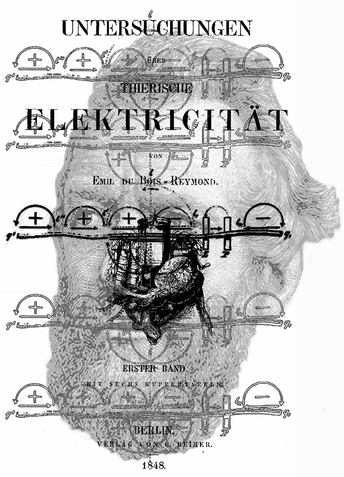Emil Du Bois-Reymond1818–1896
Du Bois-Reymond was a student of Johannes Müller, who occupied the chairs of physiology and comparative anatomy in Berlin. Müller encouraged him to study nerves and it in this area that he achieved his fame. He succeeded Müller in the chair of physiology, although he rejected his mentor’s vitalistic views. Together with his colleague and friend, Helmholtz, and others he sought to explain biological processes exclusively on the basis of physico-chemical principles. Besides being a man of science, du Bois-Reymond was a man of a great philosophical, historical and literary culture, already evident in his doctoral dissertation, published in Latin in 1843, dealing with the history of electric fish research. As in his future scientific and philosophical writing, he showed a complete mastery of the historical sources in the field, including Greek and Latin classics. Some of du Bois-Reymond’s philosophical and general culture writings, and particularly those on the limits of human understanding, are so famous that the author is known to philosophers as well as to scientists. His electrophysiological research, which occupied all his scientific life, led to the two volumes of his monumental Untersuchungen über thierische Elektricität; it is one of the classics of the nineteenth century science. The main experimental achievement of du Bois-Reymond’s research in this field was the recording of the electric phenomena involved in the production and conduction in nerves (dubbed by him as negative Schwankung, meaning negative “oscillation” or “variation”). To account for his results, and to provide an explanation of electric phenomena in excitable cells, he put forward his “electric molecules” theory. This was based on the assumption of the presence in the resting fibre of and orderly arrangement of charged molecules, which would be perturbed by physiological or experimental stimuli, leading to the propagated electric wave. Although founded on partially flawed experimental data (and eventually strongly criticised by his former student Ludimar Hermann), this theory laid the ground on which Julius Bernstein, another of du Bois-Reymond’s students, would build his landmark “membrane theory”. In the cases of electric fish du Bois-Reymond obtained a series of important experimental results by working directly or indirectly through his students, especially Carl Sachs (1868-1943) and Fritsch, on all the three species of fishes capable of giving a strong shock (i.e. torpedo, electric catfish and electric eel). However, also in this case he was not able to provide an acceptable theory of the fish discharge, leaving this fundamental achievement to Bernstein. Du Bois-Reymond published the first volume of his investigations of animal electricity in 1848, and his portrait is shown within the title page; this provides a vignette of various aspects of his work including the instruments he used and the preparations he studied. Superimposed five times on the illustration is his diagram of nerve transmission, taken from his book.
